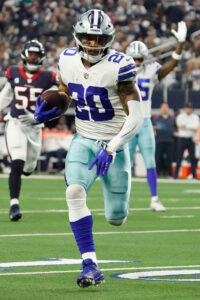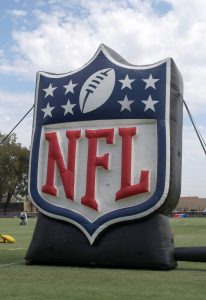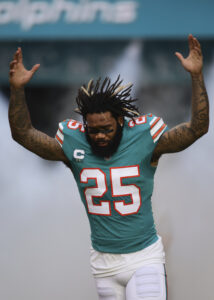One of the key talking points during the 2023 offseason was the continued downward slide of the running back market. High-profile players at the position met to discuss the matter, but to little surprise those efforts did not yield a firm plan for the future.
Three backs were hit with the franchise tag last spring: Saquon Barkley (Giants), Josh Jacobs (Raiders) and Tony Pollard (Cowboys). The latter quickly decided to sign his one-year tender, but the other two took until well past the deadline for extensions to be worked out for their immediate futures to become clear. Both Barkley, and later Jacobs, agreed to one-year pacts worth a higher maximum value than those of the tags. Now, all three face the prospect of a second tag or – far more likely – a trip to free agency.
With the RB market set to feature a longer list of names in 2024 than it did last offseason, teams will have a number of experienced options to choose from. An evaluation of each ’23 tag recipient’s performance this past year will no doubt be a key factor in determining the value for Barkley, Jacobs and Pollard. Here is a side-by-side look at each back’s production in 2022 compared to their totals while playing on the tag (or one-year equivalent):
Saquon Barkley (Age in Week 1: 27)
2022 (16 games): 18.4 carries per game, 1,312 yards, 10 touchdowns (57-338 receiving statline)
2023 (14 games): 17.6 carries per game, 962 yards, six touchdowns (41-280-4 receiving) 
The Giants ran up against the 2023 tag deadline needing to find a way forward with both Barkley and quarterback Daniel Jones. The four-year, $160MM commitment made to the latter allowed the tag to be used on the former, despite his track record as the focal point of New York’s offense when healthy. Barkley missed time in 2023 due to an ankle injury, and the Giants underperformed with and without him during a forgettable campaign. Still, New York’s offense will be lacking in playmakers even if Barkley is retained for 2024.
A trip to free agency is now expected, though, something the former No. 2 pick has publicly welcomed. No doors have been shut with respect to a Giants agreement being reached, but few circumstances (if any) have tangibly changed compared to last year. New York made a series of offers with an inversely proportional relationship between AAV and guaranteed figures during last offseason’s negotiations and a different approach this time around would come as a surprise.
Barkley out-rushed backup Matt Breida by 811 yards, so his departure would create a massive void at the RB spot. The Giants are likely to use the No. 6 pick in April’s draft on a much-needed offensive playmaker or a Jones successor, and either move will help their outlook in the passing game. The ground attack would face serious questions without Barkley in the fold or an impactful replacement, although one could be acquired in a more cost-effective manner through the draft or a short-term veteran addition. Barkley’s pedigree could make him the most attractive free agent running back option in 2024, and it would be interesting to see how willing New York would be to win a bidding war.
Josh Jacobs (Age in Week 1: 26)
2022 (17 games): 20 carries per game, 1,653 yards, 12 touchdowns (53-400 receiving)
2023 (13 games): 17.9 carries per game, 805 yards, six touchdowns (37-296 receiving)
 Jacobs led the NFL in touches during the only full season with Josh McDaniels at the helm. That resulted in league-leading rushing and scrimmage yard totals, but the Alabama product saw a downturn in usage on the ground and in the air when on the field in 2023. His missed the final four games of the campaign, a span during which McDaniels’ replacement (Antonio Pierce) helped his case to have the interim head coach label removed.
Jacobs led the NFL in touches during the only full season with Josh McDaniels at the helm. That resulted in league-leading rushing and scrimmage yard totals, but the Alabama product saw a downturn in usage on the ground and in the air when on the field in 2023. His missed the final four games of the campaign, a span during which McDaniels’ replacement (Antonio Pierce) helped his case to have the interim head coach label removed.
Pierce is indeed in place on a full-time basis, something Jacobs and a number of other players endorsed. Vegas is willing to explore a deal with the two-time Pro Bowler, but the price point will be worth watching with respect to new general manager Tom Telesco. The latter was in charge of a Chargers regime which allowed Austin Ekeler to seek out a trade in lieu of extending him. Ekeler joined Barkley and Jacobs in agreeing to a re-worked pact last offseason which has him in line for free agency this March. Telesco could be inclined to repeat his aversion to a long-term RB commitment in Jacobs’ case.
The Raiders have a potential Jacobs replacement in the form of Zamir White. The 2022 fourth-rounder averaged 4.1 yards per carry this season, and he eclipsed 100 rushing yards in two of the four games Jacobs missed to finish the campaign. White has two years remaining on his rookie contract, so placing him atop the depth chart and drafting another member of the backfield would be a more cost-effective direction to take. Vegas is expected to pursue a quarterback addition, something which could require cap resources otherwise available to Jacobs if it takes the form of a free agent signing or trade acquisition.
Tony Pollard (Age in Week 1: 27)
2022 (16 games): 12.2 carries per game, 1,007 yards, nine touchdowns (39-371-3 receiving)
2023 (17 games): 14.8 carries per game, 1,005 yards, six touchdowns (55-311 receiving) 
As expected, the Cowboys moved on from Ezekiel Elliott once no guaranteed salary remained on his deal. That paved the way for Pollard to take on an undisputed No. 1 role in 2023, as showcased by his increased touches. The Memphis alum’s efficiency suffered a notable drop, though; his 4.0 yards per carry in 2023 represented the lowest of his career. With questions in place regarding Pollard’s production as a full-time starter, a lucrative deal would increase expectations in his production further while complicating an already unenviable cap situation.
Dallas’ offseason will be defined in large part by the team’s ability to work out a Dak Prescott extension. The veteran quarterback possess extraordinary leverage in advance of negotiations on a pact both sides are eager to hammer out. The Cowboys will likely also need to prepare market-setting extensions for wideout CeeDee Lamb and edge rusher Micah Parsons over the next two years, and re-signing Pollard would hinder those efforts. Allowing him to depart would create a major vacancy in the backfield, though.
Pollard and second-leading rusher Rico Dowdle (361 yards) are both pending free agents. The leading Cowboys rusher amongst RBs who are under contract for next season is Deuce Vaughn, who received only 23 carries as a rookie. Pollard has considerably more tread left on his tires than Barkley, Jacobs and a number of other free agent backs due to his time as Elliott’s backup. That (coupled with the lack of an obvious successor) could help his value and his effort to secure longer term on his next contact, albeit something which will come off the back of a relatively underwhelming year. At any rate, a tag for Pollard or any other Cowboy would come as a surprise.
The 2023 franchise tag cost $10.1MM at the running back position. In the case of Pollard and Barkley (whose one-year deal contained incentives paired with an identical base value), a second tag would cost $12.1MM. For Jacobs – who landed a slightly higher salary on his contract – a 2024 tag would check in at a price of $13.67MM.
Considering the performances of each member of the trio, their respective teams could aim to take another route this offseason and likely save considerable cap space in the process. Given the nature of their statistical showings, hesitancy on the part of interested teams with respect to a new agreement after another season of wear and tear would also be understandable. Further hurting the market for Barkley, Jacobs and Pollard is the depth of other veteran rushers set to be available.
Ekeler, along with two-time rushing champion Derrick Henry, is a pending free agent. The same is also true of 25-year-olds J.K. Dobbins and D’Andre Swift, who have each played out their rookie contracts and could profile as having higher upside given their age. While this year’s draft class is not viewed as having a plethora of impact prospects, recent history has shown teams can find production after Day 1 when looking to avoid expensive commitments at the position. For Barkley, Jacobs and Pollard, those factors will likely make it a challenge to secure multiple years of guaranteed money on their next pacts, regardless of where they come from.
 [RELATED: Saints Restructure C Erik McCoy’s Contract]
[RELATED: Saints Restructure C Erik McCoy’s Contract]







